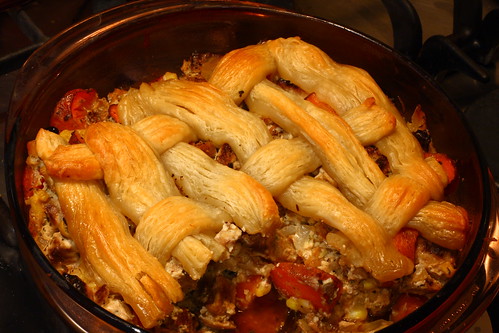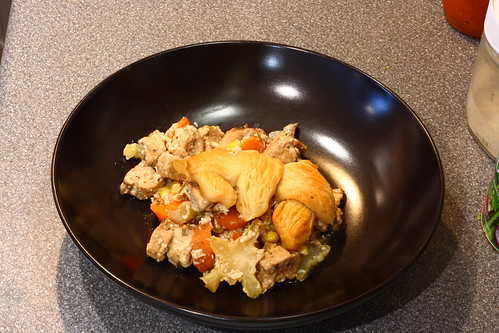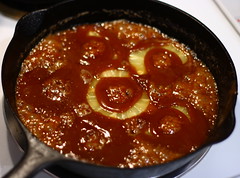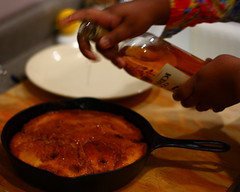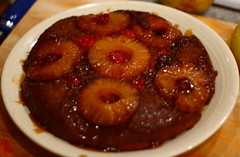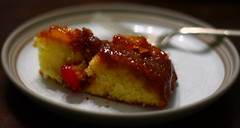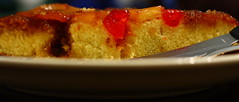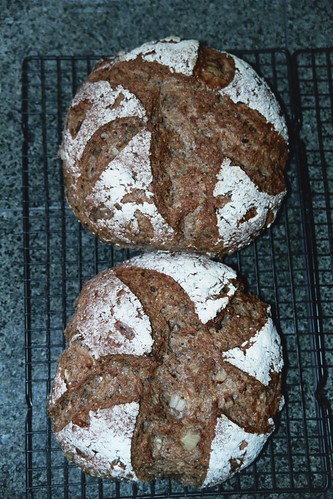The problem is, I don’t really like pastry.
I have been known to eat the middles out of pies. I tend to leave the casings of sausage rolls and filled pastries. This makes me really, really weird, I realize that. Part of the problem is that growing up, I didn’t like the way oily things felt in my mouth — so shortbread was out, making me the lone child who didn’t enjoy seeing the tin of Dutch Christmas cookies arrive each year. I love small plates, and appetizer-y things like samosas — but only one of those a year is fine, sadly, or I feel a little sick. Bear claws or other store-bought Danishes, and laminated doughs of all types have made me a little queasy, and if the pastry is a minute past fresh, or I can taste or feel the oil on my mouth at all — oh, no. Bad, bad times.
Arriving in Glasgow, Land of the Fried, Home of the *Braue, this pastry aversion presented somewhat of a problem. There are tons of tasty Scottish items which are concealed in pastry, or fried (egg rolls — which are not Chinese food, I discovered. Egg+hamburger bun+frying= egg roll), and butter is, of course, as well-loved here as it is at home. (Paula Deen heaven, people.) Lovely Scottish shortbread, buttery crisp oatcakes, and the ubiquitous Scottish (vegetarian) sausage roll all presented a challenge (meanwhile, D. eats them up happily, claiming my forebears come from people who apparently ate leaves and twigs, while his properly ate fat and fish). I wanted to embrace the food of my current residence, but didn’t know where to begin.
I purchased a package of frozen pastry, deciding to start small, and make something with minimum effort. Unfortunately, nothing really suggested itself until one of those bitterly cold afternoons when I was expecting D. to come home frozen from school. He came in while I was hauling out ingredients, and frowned.
“Why aren’t you using the broccoli?”
“In pot pie?”
We then had one of our long, rambling and ridiculous discussions about what goes in what; my take was that broccoli never goes in pot pie, his view was that whatever you put in it goes quietly, or you should probably have killed it first.
We compromised by me sitting down and reading a book while he futzed with the broccoli, then lost interest.
(You see the rate at which dinner is prepared? You’d think we’d be much thinner, but no.) Eventually we returned to our project, and put together:
Some Kind of Pot Pie
- 1 whole onion
- 1/4 c. frozen corn
- 1 clove of garlic
- 3 chopped carrots
- 1 cup of the stems of fresh broccoli
- 1/2 c sliced mushrooms
- 1 package of silken tofu
- 2 c. frozen Quorn bite-sized “beef” chunks
- 1/2 c. milk or water,
- 1 tbsp. cornstarch
- 2 tsp. lemon juice
- various crumbled herbage, including chives, oregano, garlic and onion powder, black pepper and salt to taste,
- And one package of store-bought puff pastry
We started by using a stick blender and combining the tofu, milk and cornstarch, making the silken tofu into a kind of sauce. (If you’re not using tofu, you could just make a white sauce.) Next we threw in our herbs, spices, pepper and salt. Finally when we had a creamy sauce we dumped everything else in and gave it a quick stir, just to be sure everything was coated. This is a one-dish casserole, and so we left it in the dish in which it was combined.
We intended to use the puff-pastry normally — take it out of the package, roll it out, etc., but D. had the bright idea to use the pizza cutter and slice the puff pastry against the grain. Together we wove it in a vague approximation of a basket-weave. We then popped it into the oven for 40 minutes, not because it really needed to cook for that long, but because we mostly forgot about it ’til we could smell it.
(Oh, come on. Honestly: isn’t this how many of your dishes begin and end?)
This was not a picturesque, pretty dish, but you know, most of the time, that just doesn’t matter. It was hot and savory and filling yet light — one of those really, really surprisingly good casserole-y meals that just worked well. And best of all, I really liked the top. It might be because there was no oil or fat whatsoever in the filling — the laminated pastry topping provided just enough richness to make a tasty dish, but not too much.
After that accidental beef-esque pot pie, I’m feeling brave, and may take on some of the recipes which have eluded me like pasties or the lovely tomato tarts I’ve seen other people make. Eventually, I may even learn to like D’s guilty pleasure dessert, millionaire shortbread!
But, for some reason, D. says that’s not really necessary.
*Splendid and brave, of course.
Apparently, I should also be trying to learn how to make a Brack this year… Oh, the horror.
